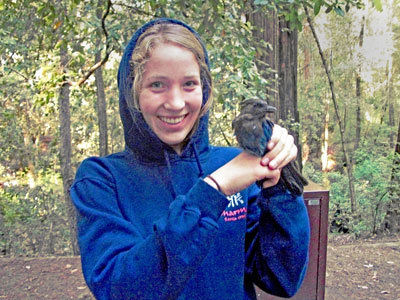
“A jay’s gifts and instincts, and feelings, and interests, cover the whole ground. A jay hasn’t got any more principle than a Congressman.” — Mark Twain
“When I was young I remember riding my donkey, Frolicker, down Ben Lomond Mountain to go to the post office and feed store,” Elizabeth Reid-Wainscoat said. “I grew up surrounded by beautiful trees and being able to go for a hike starting in my own backyard.”
How did the natural wonders of the San Lorenzo Valley impact her life decisions? Reid-Wainscoat is now majoring in environmental ecology at University of California, San Diego.
Last summer, she was offered the opportunity to study the population of Steller’s jays in the Big Basin area with a doctoral student at the University of Wisconsin, who is writing her dissertation on the bird.
The Corvidae family, which includes crows, ravens and jays, has been listed as among the world’s most intelligent animals. The birds have even been observed using tools.
“We were out all day, six days a week, capturing jays in mist nets,” the Ben Lomond native said. “We were putting bands on them and equipping some with radio transmitters, which we used to track them. I would take a blood sample, so we could identify the isotopes in their blood to see where their food was coming from and compare forest birds to campground birds.”
As expected, the jays in the forest had a significantly bigger home range than the campground jays.
“The fact that Steller’s jays have overpopulated our area allowed us to get a lot more data and get closer to the birds than the mountain lion project. Our mission is really important, because the marbled murrelet, an endangered species, is a sea-dwelling bird who nests in the redwoods — very unique. The data helps us know how we can do population management, because the Corvidae are really depleting the marbled murrelets by preying on their nests.”
As human development has expanded into the coniferous forests where the Steller’s jays range, new food sources have developed for them, increasing their population.
“People in campgrounds leave their trash, and some people even feed them, because they think it’s entertaining,” Reid-Wainscot said.
Steller’s jays have adapted their foraging strategies around human activity.
“They know when people are leaving a campground, and they’ll wait in the trees,” she said. “We told campers about the problem, and they said they would try harder to pack their trash. There’s not enough staff at the park to provide information and enforcement.”
The first time I saw the cobalt-and-black bird was at my mother’s feeder in a skiing community in New Mexico. It looked similar to the blue jay I was familiar with in Texas, and I asked what it was. She replied that it was a “stellar jay” — or at least that’s what I thought she said.
Actually the Steller’s jay — like the Steller’s sea eagle, Steller’s eider and Steller’s sea cow — was named for German botanist and naturalist Georg Wilhelm Steller, who sailed on a Russian research expedition in 1741. He made scientific discoveries in western North America more than 60 years before Lewis and Clark’s journey.
“This bird alone sufficiently convinced me that we were really in America,” Steller wrote in his journal about the jay.
He remembered a description of an Eastern blue jay described in a 1783 book. Although the bird was a different species, blue-crested jays live only in the Americas.
The expedition was the first to find and chart the coastline of northwestern America, sending back valuable specimens to the Botanical Gardens of St. Petersburg. And Steller was the first person to theorize that humans came to America from Asia, crossing the Bering Strait, named later for the captain of his ship.
Although the Steller’s jay has been vilified, it holds a place of honor as Alaska’s state bird. I think of the noisy visitor as the sentinel of the forest, cawing loudly when predators approach, notifying me when snakes and bobcats are close by.
– Carol Carson, M.Ed., is a naturalist, writer and educator.












